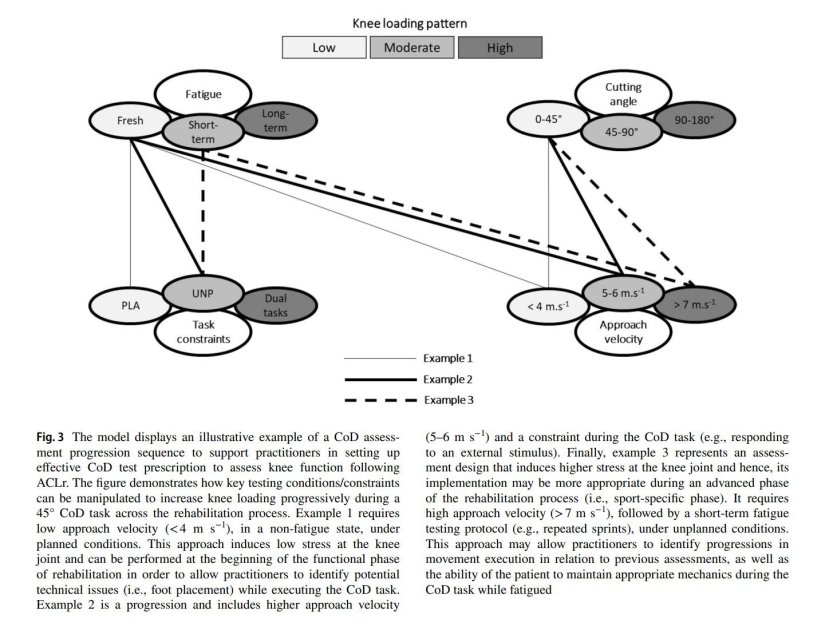Review Change of Direction Assessment Following Anterior Cruciate Ligament Reconstruction: A Review of Current Practice and Considerations to Enhance Practical Application
Return to sport following ACL reconstruction (ACLr) have often focused on strength and single-leg hop tests, with a paucity of evidence to describe the CoD characteristics.
Three feld-based testing protocols have commonly been adopted. These includes the shuttle run, co-contraction, and carioca tests. However, it is important to critically appraise their use as CoD tests. Specifcally, the movement patterns displayed bears little to no resemblance of how an athlete would move in a sport-specifc setting, particularly during cutting and turning maneuvers.

Competitive vs. Non‑competitive: The essence of all sports is competition. Movements that occur in a laboratory environment will likely be different from movements in real game situations. Performing testing in the laboratory environment is easier to control experimentally but does not consider the presence of opponents and teammates.
Planned vs. Unplanned: Rarely in match play do rapid direction changes take place in optimal conditions where athletes have time to select the appropriate movement strategy. Risk factors for ACL injury are also higher during unplanned CoD maneuvers due to the greater external load and mechanical stress placed at the knee joint. This lack of realistic scenario may limit our ability to fully understand the impact of a true un-planned ‘agility’ action on ACL injury risk and this point is further highlighted by recent research.
Fatigued vs. Non‑fatigued: Change of direction assessments are typically conducted when athletes are in a fully recovered state. In most sports, fatigue and agility tasks rarely exist independent of one another; thus, their combined manifestation may present as a worst case scenario in terms of injury risk. Studies have attempted to examine fatigue-induced changes in lower extremity mechanics and their association with ACL injury risk following prolonged activities
Cutting Angle: The magnitude of the load placed on the knee joint will be largely determined by the CoD angle required to perform the test. Data indicate that greater posterior and laterally directed forces are present for sharper CoD angles.

Dual Cognitive Task: During CoD tasks performed in competitive situations the cognitive load is increased since the athlete must allocate attentional resources to manipulate the ball and must also be aware of the location of their opponents, teammates and the goal and this in part may contribute to the higher risk of ACL injury during such movements.
Practical Applications

Conclusion: CoD assessments have not been widely implemented by practitioners as a criterion measure to inform RTS decisionmaking. Furthermore, current feld-based practices do not appear in agreement with relevant sport demands, or efective in their assessment of knee function following ACLr. uring rehabilitation. In this review we have detailed a number of factors for the development of future practice in the area of CoD assessment following ACLr and provided suggestions for how these can be incorporated.